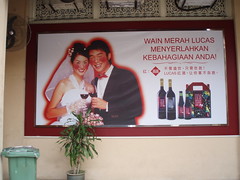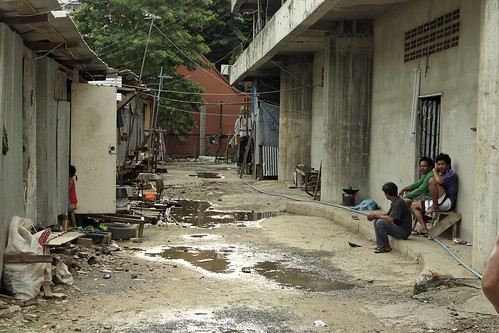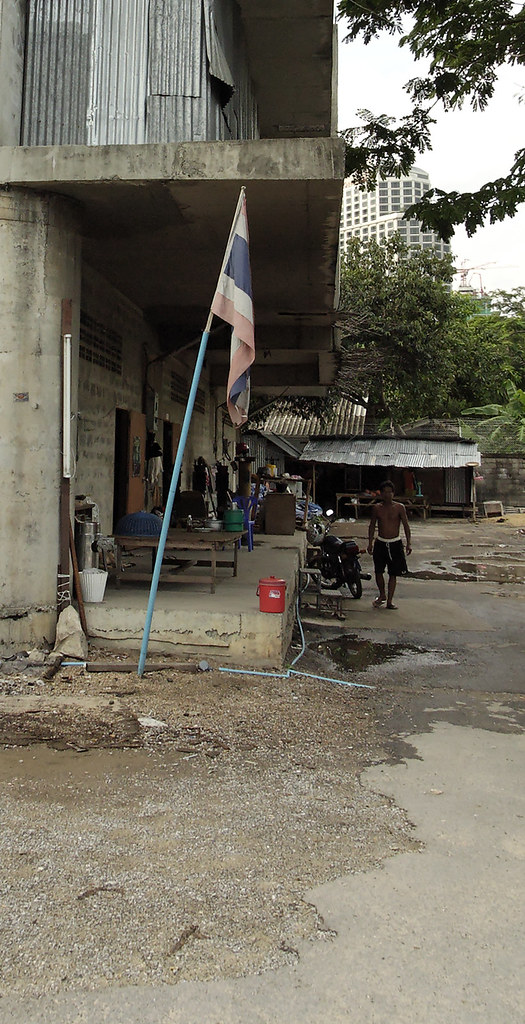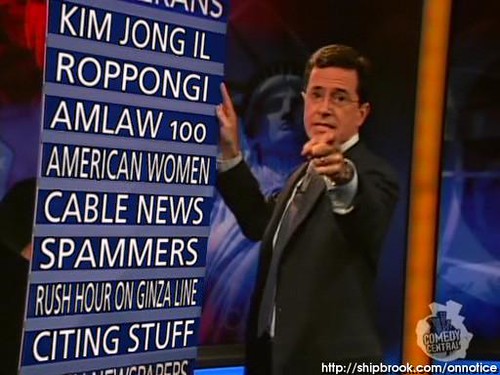Taken outside a Chinese liquor shop in Chinatown, Penang, Malaysia.
Month: October 2006
Squatting in Bangkok [photos]
Visa run to Penang… so far so good
For some reason I didn’t bring the USB link to my camera, so you’ll have to wait until Friday or so before I can show you this place. From what I’ve seen, Penang is much more laid back than, say, the tourist destinations in Thailand. The island is somewhat big and tourism is not the only industry. I’m staying in the Chinatown neighborhood of George Town, the largest city. Being the diverse mix of ethnic Malays, Chinese, and ethnic Indians, that Malaysia is, the streets are a mix of Chinese street signs, Indian curry shops, colonial buildings (the settlement was started on this previously uninhabited island by the British East India Company in the 18th century), and various religious buildings of various faiths.
Today is a national holiday marking the end of Ramadan. I woke up to the sound of the Muslim call to prayer and went to eat breakfast at the Blue Diamond, a hotel for Western tourists that features Mexican food, Metallica on the stereo (the new shitty Metallica), and some old dude banging on the drums randomly. While the tacos I had last night were kind of crappy (poor quality beef, not enough cheese, needless over-spicing), the breakfast service was pretty good. Fresh orange juice, eggs, sausage, beans, toast, and what was probably the best cereal I’ve ever had – oats and nuts topped with mixed fruits and unsweetened yogurt, kind of a tropical proto-cereal – yum!
Unlike Thailand, almost every one of the locals seems to speak passable English, though their manners could use some work. People barely look at you when serving, except for some of the Indians. To my surprise the most prominently-sold newspaper was the English-language, tabloid format Straits Times, but it wasn’t all that useful to me as it focuses almost exclusively on domestic affairs – the international section consisted of two articles from the New York Times and 3 pages of AP clippings.
I’m here to renew a tourist visa as I continue my job hunt – what should have been a one or two night trip turned into a 4 night excursion since I made the blunder of booking a flight on a major holiday when the consular offices are closed. Before coming I was worried about the validity of my passport since the week before I accidentally put it through the laundry. But those fears seem to have been unfounded since, well, here I am.
That passport is now in the hands of a man named Mohammed at NJ Book Centre, leaving me in a state of limbo until I get my renewed visa and can head home on Friday. Until then, I plan to read Bob Woodward’s State of Denial, visit some of the historical sites, and take a lot of pictures. Stay tuned!
My Mexican Experience in Thailand – ¡muy malo!
As part of the week-long birthday festivities for Mrs. Adamu, on Friday we had the chance to visit Charley Brown’s Tex-Mex Cantina, one of the few places in Thailand that can claim to serve anything close to Mexican food. I ignored Cosmic Buddha’s reservations about the place and decided to go anyway. Some thoughts:
Recommendation: unless you have no problem with sex tourism and are sure that you’ll never ever visit a part of the world with good Mexican food again, stay away from Charley Brown’s.
You’re on notice!
Allow Japanese nukes?
Washington Post columnist Charles Krauthammer has a silly and misinformed column arguing that the US needs to allow Japan to arm themselves with nuclear weapons to protect against North Korea. Right. The nuclear weapons program that Japan has been longing for all these years and has only refrained from starting because of US pressure.
Japan is a true anomaly. All the other Great Powers went nuclear decades ago — even the once-and-no-longer great, such as France; the wannabe great, such as India; and the never-will-be great, such as North Korea. There are nukes in the hands of Pakistan, which overnight could turn into an al-Qaeda state, and North Korea
I’m frankly surprised at how bad his reasoning is in this column, how much it sounds like the writing of an enthusiastic but narrowly informed freshman in Poly-sci class.
The fact of the matter is that Japan does not have nuclear weapons because the Japanese population is almost unanimously opposed to the idea. Yes, a couple of higherups in the LDP have suggested the idea of maybe talking about considering discussion of the issue, but quite frankly I cannot think of a better way for them to finally start losing elections seriously than to make the acquisition of nuclear weapons part of their official party policy.
His last paragraph is particularly absurd.
Why are we so intent on denying this stable, reliable, democratic ally the means to help us shoulder the burden in a world where so many other allies — the inveterately appeasing South Koreans most notoriously — insist on the free ride?
This is a mind boggling reversal of reality. Yes, South Korea has been friendly to North Korea. (Unlike some people they actually have to live next door to the crazy man with the gun, which suggests a different perspective from the other side of the Pacific.) But they also have a draft for all adult males, which can hardly be a free ride. Not to mention that fact that South Korea actually DID have a program to develop nukes a couple of decades back, which the US forced them to abandon.
On the other hand, Japan actually DID have a long-term policy of insisting on a free ride. Following the end of the US occupation, the US actually tried to persuade the Japanese government to abandon the principle of pacificism that the US had forced on them only a few years before, and rebuild their military so that they could participate in the Korean war. Japan refused to have even a token military for many years, using the pacifist constitution as an excuse to keep from spending any national resources, capital or human, on military or weapons-a policy that was partly responsible for the country’s fantastic industrial development.
Cold economics were of course not the only reason for Japan to keep from investing in a military for so long. After the disastrous defeat of World War II, culminating in the only use of a nuclear weapon so far, were was also a widespread belief that war was a failed strategy for national success, and that lesson has over the decades transformed into a very strong and nearly universal value of national pacifism.
I see political campaign posters every day calling for the protection of the pacifism clause of the constitution (Article 9), and anti-war and especially anti-nuclear messages are more common and mainstream here than in any other country of which I am aware. In fact, I have never even seen a public protest or demonstration in Japan that did not include that message in some capacity.
I think this comment left by some Japanese person on the Washington Post site says it well.
Get a grip Charlie. While there is an active right wing here of course, the majority in this country where I live is so opposed to nuclear weapons that it would defy your comprehension. Many people here would simply choose non-existence total elimination of both the nation and state of Japan over nuclear weapons possession, let alone use. The Japanese government would run out of fire hoses to put down the demonstrations. Calls for a nuclear Japan are still very premature, and indicate a lack of familiarity with the culture. It aint gonna happen anytime soon.
I think the bit about choosing “non-existence total elimination of both the nation and state of Japan” is frankly over the top, and if Japan were faced for some reason with a genuine war they would came around to full acceptance of their military, but not as things stand now.
Japan’s best offense is their lack of capability for offense. Yes, North Korea distrusts Japan more than anyone, but even they know that Japan is bound by their constitution, laws, and tradition not to use their military for combat purposes unless they are attacked first. North Korea does have to worry about the very real (if unlikely) threat of military action on the part of the US, South Korea or even China, but as long as they do not attack Japan first, Japan is no threat to them-and that more than anything else is what keeps Japan safe today.
[Addendum]: I should have mentioned that the policy of specifically relying on US military protection and instead developing the industrial economy is not a theory of mine, but the Yoshida Doctrine, named after the postwar Prime Minister Shigeru Yoshida , who was incidentally Aso’s grandfather.
Kyoto universities
At lunch today my friend Osamu told me these two sayings that were current about twenty years ago in Kyoto.
First, for a woman choosing which of the three famous universities in the city to go to:
If you want a boyfriend, go to Doshisha (because that’s where the kids from rich families go.)
If you want a husband, go to Kyoto University (because they’ll all have good jobs in the future.)
If you want a bodyguard, go to Ritsumeikan (because the kids from working class families that want to study go.)
Second, what people said about Ritsumeikan.
Akai, kurai, dasai.
And in translation: Red(as in communist) , dark/dour, unfashionable.
Don’t laugh, some day we’ll ALL be wearing one of these
In this photo released by Japanese electronics maker Toshiba Corp. Monday, Oct. 16, 2006, a model wearing a full-faced prototype headgear demonstrates the new gadget that enables the wearer to get a 360-degree view on a 40 centimeters (15.8 inches) across dome-shaped screen at Toshiba Corporate Research and Development Center in Kawasaki, west of Tokyo, Wednesday, Sept. 20, 2006. The ominidirectional image, of which two-dimentional version is displayed on the flat panel screen, will be projected to the three-kilogram (6.6 pounds) helmet in accordance with the wearer’s head position upon being detected by infrared sensors. Toshiba plans to merchandize the gadget within 2 to 3 years. (AP Photo/Toshiba Corp., HO)
(Thanks to CRAZY JAPAN)
Superheroes: Good and Evil in American Comics
 If you enjoyed my recent posts on WW2 era comic book covers and are in the New York area, you may want to check out Superheroes: Good and Evil in American Comics, an exhibition running at The New York Jewish Museum from September 15, 2006 to January 28, 2007. Curated by Jerry Robinson, whose best known creation is The Joker, possibly the best known comic book supervillian of all time, showcases art from the golden age of comic books (from the popularization of the art form in the late 1930s until it came under a period of attack in the early 1950s) in the context of the socio-political conditions of the time. Naturally, since this is The Jewish Museum and the vast majority of early comic book creators were Jewish, there is a strong focus on the relationship that these creators’ Jewish identity had to their art.
If you enjoyed my recent posts on WW2 era comic book covers and are in the New York area, you may want to check out Superheroes: Good and Evil in American Comics, an exhibition running at The New York Jewish Museum from September 15, 2006 to January 28, 2007. Curated by Jerry Robinson, whose best known creation is The Joker, possibly the best known comic book supervillian of all time, showcases art from the golden age of comic books (from the popularization of the art form in the late 1930s until it came under a period of attack in the early 1950s) in the context of the socio-political conditions of the time. Naturally, since this is The Jewish Museum and the vast majority of early comic book creators were Jewish, there is a strong focus on the relationship that these creators’ Jewish identity had to their art.
Comic book news site Newsarama has a very interesting interview with Jerry Robinson about the exhibit.

NRAMA: Do you have any insight into why Jews were such a big part of the comic book industry in the beginning?
JR: I’ve done a lot of research on this and it’s going to become a book based on the two exhibitions and it will be published by one of the major art publishers in America. Jewish artists and creators have been prominent in New York culture since the turn of the century. A lot of artists, writers, poets, also scientists and other professions were in that first wave of immigration in the 1890’s/1900’s. Then the next wave was due to the rise of Nazism and that wave included a lot of artists, writers and theatrical people. So from that whole first half of the 20th Century, New York absorbed a lot of diverse talent, along with many other immigrants of other nationalities, German, Italian, Russian, etc. But many of them were Jewish and were prominent in their areas. For example, the early movie industry was also dominated by a lot of Jewish actors, writers, filmmakers from Europe. They immigrated to New York and settled in the Lower East Side and at one time there were hundreds of theaters around the country that were showing Jewish plays and performances. The film industry, again, had many prominent Jews such MGM with David O. Selznick, Carl Laemmle with Universal. I can’t name them all.
I was pleased to see that in the interview he also mentioned the exhibit’s collection of covers he chose to include Captain America #1, which earlier this week I called my favorite of the WW2 era anti-Axis covers.
Unfortunately, I will not be back home in the New York area until next summer so I will be missing out on this exhibit, but it sounds well worth visiting for anyone interested in the history of American popular culture, American/New York Jewish history, or comic books at all. And of course, while on this topic I must make a very strong recommendation that anyone with even the slightest, teeniest bit of interest in this stuff immediately get your hands on a copy of The Amazing Adventures of Kavalier & Clay by Michael Chabon. Don’t let the fact that it won the Pulitzer prize for literary scare you off. This fictionalized account of the careers of a a duo of Siegel and Schuster-esque creators of a Nazi-fighting superhero by the name of The Escapist is amazingly fun to read.
Qoogle rules
Thanks to Momus, I have discovered this sweet Japanese video site, Qoogle. It works like Digg to pick up popular videos on Youtube.
Highlight: The first episode of Doraemon. As a big Doraemon fan this is pretty sweet, complete with the lame music. And Giant’s voice is different somehow.






